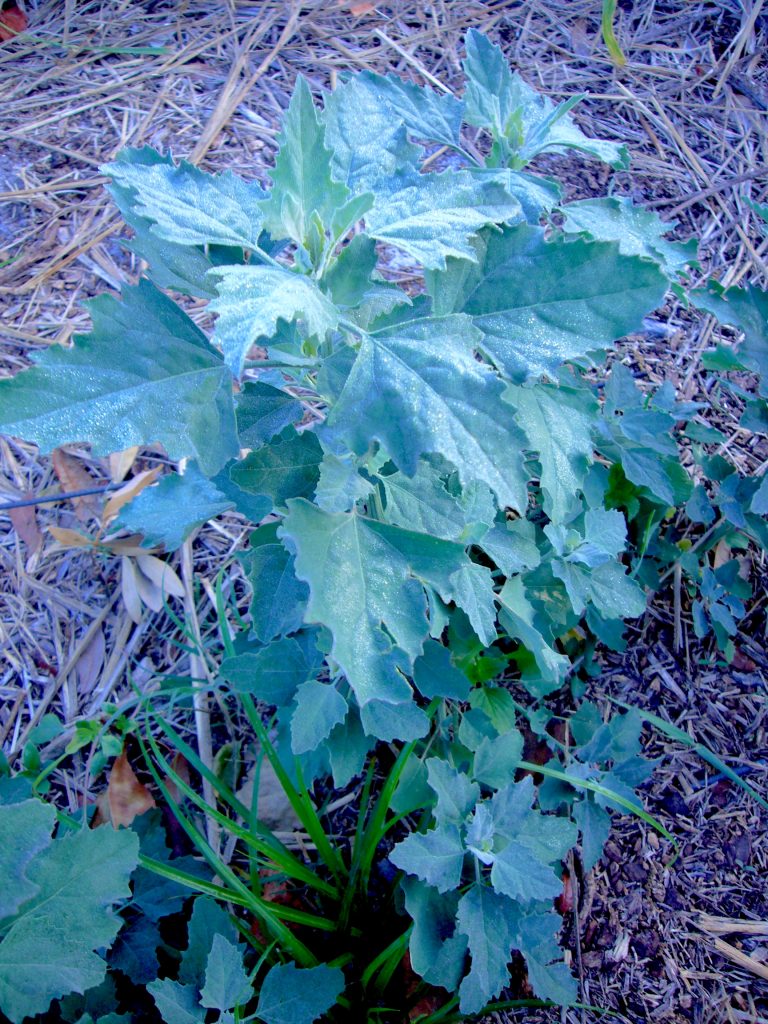
Lambsquarters often has a mealy look. Photo by Green Deane
While driving through the middle of the peninsula this week I noticed Lambsquarters in their most common seasonal place: Citrus groves. Look for them in not only well-tended groves but poorly maintained ones as well. They like the disturbed soil that annual harrowing creates. In Eagle Lake an old grove had been cleared for housing. Lambs Quarters were taking advantage of turned soil.
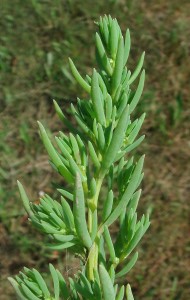
Seablite is related to Lambsquarters. Photo by Green Deane
Lambsquarters, also known as Pigweed, Fat Hen, and Chenopodium album, was a common weed in rural Maine where I grew up. It was one of the first edible wild plants I learned as a kid and rather unintentionally. We didn’t have a lawn so my father sprinkled several wheel barrows of chaff from the haybarn on the the designated soil. The first crop that spring was wild mustards which I knew were edible. The second crop was Lambsquarters. I didn’t know they were edible until a neighbor one day asked if he could take several five-foot tall plants home for supper. I added them to my “edibles” list. Other comestibles around the house were wild raspberries, apples, grapes, choke cherries, strawberries, blueberries, dandelions, sand roses and violets called “Johnny Jump Us.” They grew near the septic drank drain. My mother enjoyed eating them despite the aromatic surroundings. You can read about the Lambsquarters here.
Lambsquarters is also in the Goosefoot family and related to a “grain” you might have eaten — Quinoa — which is a Chenopodium quinoa. It’s a relative of several weeds most of us have growing in our neighborhood. And the answer to the next question is yes, our local Goosefoots/Chenopodiums have edible seeds (including Chenopodium ambrosioides, also called Epazote.) The only precaution is like Quinoa all Chenopodiums seeds must be soaked before consuming to remove bitter saponins (a natural, bitter soap.)
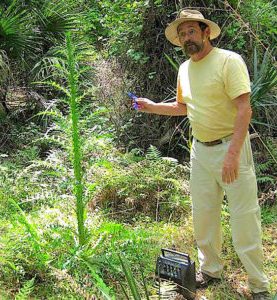
Foraging classes are held rain or shine, heat or cold. Photo by Nermina Krenata.
It might be a little rainy this weekend but fairly warm for foraging classes in West Palm Beach and Largo Fl. Weather the showers are Friday night or Saturday morning is still in contention but we will have class rain or not. In real life you’re also hungry when it rains.
Saturday, February 1st, Dreher Park, 1200 Southern Blvd., West Palm Beach, FL, 33405. 9 a.m. to noon. Meet just north of the Science Center.
Sunday, February 2nd, Eagle Park Lake, 1800 Keene Road, Largo, FL 33771. Meet at the pavilion near the dog park. 9 a.m to noon. (This class will go on as scheduled.)
Saturday, February 8th, Mead Garden: 1500 S. Denning Dr., Winter Park, FL 32789. Meet at the parking lot. 9 a.m. to noon.
Sunday, February 9th, Red Bug Slough Preserve, 5200 Beneva Road, Sarasota, FL, 34233. 9 a.m. to noon.
Saturday, February 15th, Boulware Springs Park, 3420 SE 15th St., Gainesville, FL 32641. Meet at the picnic tables next to the pump house. 9 a.m. to noon.
Saturday, March 7th, Blanchard Park, 10501 Jay Blanchard Trail, Orlando, FL 32817. 9 a.m. to noon. Meet at the pavilion near the YMCA building and tennis courts.
Sunday, March 8th, George LeStrange Preserve, 4911 Ralls Road, Fort Pierce, FL, 34981. 9 a.m. to noon. (There are no official bathrooms at this location. And don’t forget the time change. Leap forward.)
Saturday, March 28th, Haulover Canal, Merritt Island National Refuge, north of the Kennedy Space Center. 9 a.m. to noon. Read the instructions below. We meet the the northwest end of the canal area.
Sunday, March 29th, Spruce Creek Park, 6250 Ridgewood Ave. Port Orange FL, meet at the pavilion. 9 a.m. to noon.
For more information, to sign up for a class or to pre-pay go here.
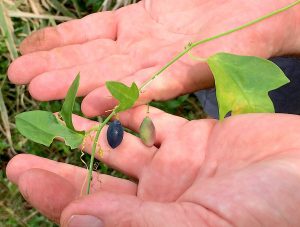
Some passion fruit are edible, some just tastes bad, and others are not edible if not deadly. Photo by Green Deane.
There are several “edible” Passiflora locally but only a couple worth eating in my tender-tummy opinion: P. incarnata and P. foetida. They both have a tart-sweet flavor and the entire fruit is edible, seeds, pulp and skin. I have eaten both but not in huge quantities, usually one or two at a time. A couple that are marginal are P. lutea and P. suberosa. I see P. lutea often but not P. suberosa which tends to grow further north. During a foraging class this week we saw P. lutea and it was fruiting. I’m a bit concerned in that I have seen some websites say P. lutea leaves can be used medicinally like P. incarnata. I would question that though I am not an herbalist nor a chemist (they would not let me take chemistry in school.) But, I seem to remember a study that tested numerous Passifloras which reported they all had some cyanide in their leaves except the P. incarnata which has GABA instead (gamma amino-butryc acid.) P. incarnata was the only one, in the study at least, that did not have cyanide in its leaves and was specifically singled out. I would be careful about using any Passiflora leaves other than wild P. incarnata without thorough research first. Also avoid unripe fruit. One species, Passiflora adenopoda, from China, is definitely fatal. You can read about Passifloras here.
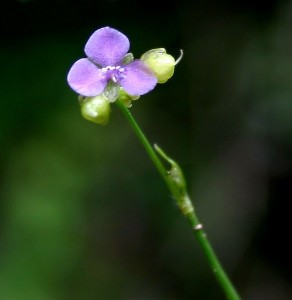
Doveweed is a little local edible.
There are many tiny edibles that don’t get much coverage probably because they’re minute or not a great flavor, read a famine food. One of them is the Doveweed, Murdannia nudiflora. Considered one of the world’s worst weed it is often found with its relatives the Asiatic Day Flower and Spiderworts. According to the Invasive Species Compendium “its special ability to root easily at the nodes, propagating clonally through cut stems and dispersal during tillage and land preparation make this weed difficult to control. This trait coupled with its ability to adapt and survive a wide ecological window of soil types, pH, moisture availability and soil drainage makes M. nudiflora a weed to watch for potential spread into new areas in near future, and a species under the ‘alert list’ by the Invasive Species Specialist Group.” It’s a big pest for such a tiny plant, one not usually seen while you’re standing up. When you are on your knees looking for something else is when you will find Doveweed. Locally I locate it in slightly damp locations and in semi- shade. As one might guess it’s similar to Commelinas and was once in that genus. To read more about the Doveweed go here.
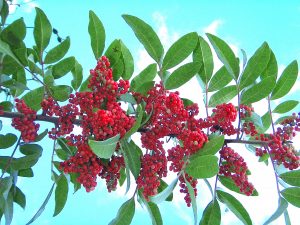
Brazilian Pepper fruit grows from axils. Photo by Green Deane
Botany Builder #10: Axil is a word you’ll read often in plant descriptions. It is the upper point where a leaf petiole (see previous Botany Builder #2) meets the stem or where a branch meets the stem. They should have called it a juncture rather than an axil. We wouldn’t be too interested in that rather unremarkable location except plants often sprout branches, blossoms and fruit from that spot. The Brazilian Pepper it puts on fruit where a larger stem and a leaf meet. Where that larger stem and — in this case — the leaf meet is the axil. Another member of this family — Poison Sumac — grows toxic white/light green berries out of the axil. A third member, however, does not. The edible sumac grows berries at the very end of a branch rather than at the axil. When the berries are in a bunch at the end of a branch it is called a terminal cluster. Thus berries growing out of an axil are in a far different location than a terminal cluster. Brazilian Pepper berries have been used as spice if you are not allergic to them as they are closely related to poison ivy. Using them is not recommendation. I have a video on the species here.
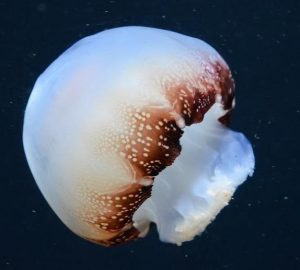
Stomolophus meleagris, one of our edible jellyfish. Photo by Deep Sea Waters.
While foraging along the Peace River this past Saturday I noticed jelly fish in the wrack line. Many jellyfish are edible including some that are found in local waters. How did I come to eat Jelly Fish? I had a friend from Taiwan who never ordered from the menu at Chinese restaurants. It was always off-the-menu and then after much discussion with the waiter and sometimes the chef. One of those chats produced a dish of jellyfish. I was hooked. It was very tasty and jellyfish can be caught while casting for other fish. (I like castnetting and am a castnet junkie.) While a substantial food in many parts of the world I’m not sure jellyfish locally would qualify as a staple because catching them by hand is by chance (which does increase however when in season.) Despite their name Jelly Fish are also mostly water and need to be desiccated immediately, not a small process. It all depends on how hungry you are and how many of them you have. You should get them live out of the water not dead on the beach. To read about jellyfish go here.

The Nine DVD set includes 135 videos.
Though your foraging may drop off during the winter it’s a great time to study wild edibles with my nine DVD set. Each DVDs has 15 videos for 135 in all. They make a great gift. Order today. Some of these videos are of better quality than my free ones on the Internet. They are the same videos but many people like to have their own copy. I burn and compile the sets myself so if you have any issues I handle them personally. There are no middle foragers. And I’m working on adding a tenth DVD. To learn more about the DVDs or to order them click here.

Green Deane Forum
Want to identify a plant? Perhaps you’re looking for a foraging reference? You might have a UFO, an Unidentified Flowering Object, you want identified. On the Green Deane Forum we — including Green Deane and others from around the world — chat about foraging all year. And it’s not just about warm-weather plants or just North American flora. Many nations share common weeds so there’s a lot to talk. There’s also more than weeds. The reference section has information for foraging around the world. There are also articles on food preservation, and forgotten skills from making bows to fermenting food.
This is weekly newsletter 390, If you want to subscribe to this free newsletter you can find the sign-up form in the menu at the top of the page.
To donate to the Green Deane Newsletter click here.


After I returned home from our Charlotte Harbor foraging class I bisected one of the four “seeds?” of the non-invasive, air potato with the rat face leaves. It looked like a regular potato on the inside, but it was more dense with no smell that I could detect. I took a small lick with no negative results so I cored out a tiny piece with my knife tip and tried it. Same result so I tried a slice without the brown exterior and again nothing bitter or sour, just a tasteless experience and the interior was quickly turning an unappealing brown so I tossed both halves toward the woods beside my house. I had no ill effects, but since I had planted the others along the woods if I decide to go get some more for French fries I will let you know how that works out. I REALLY enjoyed the poor man’s pepper, the sea purslane, hibiscus flower and the yellow flowered peas. Thanks again. btw the 2 halves were still there the next morning so evidently creatures don’t want them..not a good sign for my idea for my “air potato fries” truck.